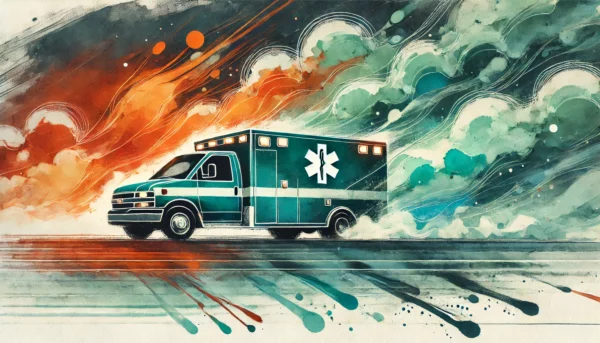ResearchMental Health, Black Boys & Men
Unnatural male deaths: Fatal injuries and the rise of drug overdoses

Summary
Deaths from fatal injuries (e.g., from external non-natural causes) have risen substantially in recent years, particularly since 2020. Men account for most of this rise, and for the majority of fatal injuries. The three most common fatal injuries for both men and women are drug overdoses, suicide and motor vehicle accidents. Drug deaths among men have risen six-fold since 2001, accounting for most of the rise in fatalities over this period.
Key Takeaways
- More than 200,000 men and 90,000 women died from injuries in 2022.
- Rates of fatal injuries among men have risen by 57% since 2001, and by 27% just since 2019.
- If fatal injury rates had remained at 2001 levels, around half a million fewer men would have died over the next two decades.
- Almost all of the increase in injury deaths come from accidental drug overdoses, which have risen by 573% for men in the last two decades.
- Drug deaths among men in their 60s are 22 times higher than in 2001.
- Deaths from drugs are now higher among Black men than among white men, a reversal of earlier trends
Injury deaths are mostly male deaths
Preventing injuries is a major priority for US public health policy. Deaths from non-natural causes – including accidents, drug overdose, suicide, and homicide – account for most lives lost before the age of 45. In 2022, there were roughly 300,000 fatal injuries. Understanding who is most at risk from fatal injuries is crucial for crafting effective prevention strategies. While injury, accidents and violence can happen to anyone, some are at greater risk than others: including men.
Figure 1
Men overall are at a much higher risk of fatal injury, as Figure 1 shows. In 2022, men accounted for nearly 70% of all injury deaths, with around 215,000 deaths, compared to about 92,000 among women. Drug overdoses were the most common type of injury deaths, representing about a third of fatalities for both men and women, followed by suicide, motor vehicle accidents, and homicides. (For men suicide is the second most common cause, for women the fourth). Note that deaths from drug overdose exclude those from a deliberate overdose, which would be classified as a suicide.
Data noteData used in this research brief were primarily taken from CDC WISQARS (Web-based Injury Statistics Query and Reporting System), which collects data on fatal injuries by various demographic characteristics over time. Provisional data for 2023 were collected from the CDC Provisional Mortality Statistics. Fatal injuries are, in the United States, external and non-natural causes of death, like suicide and drug overdose. Deaths are broken down by intent type and mechanism (e.g., unintentional drug poisoning).
Drug deaths are classified as unintentional drug poisoning deaths (using ICD-10 codes X40-X44: “accidental poisoning by drugs, medicaments and biological substances”). Note that this specification excludes alcohol-induced deaths.
Figure 2
Overall, men were two to three times more likely to die from fatal injuries in 2022. The racial gender gap is slightly larger between Black men and women, with the Black male injury death rate roughly three to four times as high as the Black female rate.
The gender disparity also varies by type of injury. Figure 2 shows the gender breakdown for the top ten causes of fatal injury. The share of male deaths ranges from 51% of fatal falls, to 80% of homicides. Men account for 71% of drug deaths. Even beyond the top ten causes, there is no injury category where women accounted for the majority of deaths.
Figure 3
Drug overdoses, suicide, homicide, and motor vehicle deaths account for a large percentage of fatal injuries for men in 2022. But the risk of a fatal injury varies by age, as Figure 3 shows. Among boys and men up to the age of 80, the highest death rates are among men in their 30s and 40s. (The accidental death rate for the over 80s is 400 per 100,000, 60% of which are from falls, not shown).
Figure 4
The cause of death varies even more by life stage, as Figure 4 shows. Boys under ten are more likely to die in motor vehicle accidents (16% of fatal injury deaths) or by other causes, like drowning (17%) and suffocation (33%). As they reach adolescence, homicide and suicide become more likely. The risks from homicide decline in middle age while the likelihood of fatal injury by suicide or motor vehicle accident remains largely stable. However, the likelihood of dying from a drug overdose continues to grow, making up nearly half of all injury deaths for males aged 30-59.
Fatal injuries rising, especially for men
Deaths from injuries have increased significantly in recent years, especially for men. Figure 5 shows the age-adjusted death rate from fatal injuries by gender over time. Since 2001, the fatal injury rate for men has risen from approximately 80 per 100,000 to almost 127 in 2022, an increase of 59%. Throughout this period, the male injury death rate has remained consistently around two-and-a-half times higher than women’s. There has been a particularly notable increase in the magnitude of fatal injuries for men since 2014, and a large jump of 23% since 2019 (compared to 2022).
Figure 5
There is no doubt that more risk-taking behavior among boys and men explains a significant part of the gender differences in fatal injuries. But the change in level over time shows that it cannot be the whole story. The rapid recent rise cannot reasonably be explained by a sudden increase in risk appetite among boys and men; and the rate has gone up among women and girls, too. In addition, while these trends accelerated during the onset of the COVID 19 pandemic, they remain elevated. These trends point to a more complex set of causes.
Figure 6
In 2001, drug overdose accounted for roughly one-tenth of male fatal injuries. By 2022, it was more than a third, as shown in Figure 6. Drugs went from the fourth most common injury death to the first. This dramatic increase is highlighted by a clear jump in 2020. Though other injury deaths have also seen increases over this time period, none compare to drug deaths in both overall scale and rate of increase.
Male deaths from drug overdose have increased by a massive 573% since 2001. For other causes of death the rise has been less stark, but still substantial: suicide (59%), homicide (29%), and car accidents (11%).
The scale of the number of lives lost as a result of these increases is huge. Between 2001 and 2022, we have lost around 414,000 more men than would have died if rates had stayed at their 2001 levels. To put this loss in perspective, it is higher than the death toll among U.S. soldiers in World War II. For women, the additional loss of life is around 207,000.
The drug crisis is well-documented, especially within the broader “deaths of despair” narrative, which highlights social and economic factors that drive substance abuse. However, even with increased awareness, the crisis has deepened, largely due to the notable increase in the supply of synthetic opioids, like fentanyl.
As this problem continues to evolve, its impact on different populations may change, making it crucial to monitor these shifts and understand the underlying subgroup dynamics. A closer look at the severity and growth of drug deaths reveals staggering increases for some groups of men.
Figure 7
While drug deaths have risen for men across all age groups, they have increased most rapidly for middle-aged men and those nearing retirement, as seen in Figure 7. As noted above, men aged 30-59 have the highest death rates, and have seen a huge increase. But men aged 60-69 have actually seen the biggest increase, 22-fold, from an initially low base.
Although the largest increases in death rates are among older men, there has also been a significant rise among younger men. For men aged 20-29, the drug overdose rate was five times higher in 2022 than in 2001. Clearly, men of all ages are suffering from drug deaths, which have reached unprecedented levels in the past twenty years.
Figure 8
Analyzing drug deaths by race reveals some diverging trends. While from an absolute perspective, white American men have the highest absolute number of drug deaths at roughly 43,000, there have been many shifts in prevalence of drug deaths by race, as seen in Figure 8.
The recent history of drug overdose deaths has some distinct phases:
- Early 2000s: Most racial groups had relatively similar drug death rates.
- Mid 2000s to Mid 2010s: Death rates among white men and Native American men death rates accelerated while other groups increased more gradually.
- Late 2010s: Growth rates start to slow down for white men, and pick up for most other races.
- In 2020: Coinciding with the pandemic, an acceleration of deaths for all groups, but most dramatically for Black, Native American and white men.
- By 2022: Native and Black men face the highest prevalence of accidental drug deaths.
Over the entire time period, Native American men experienced the highest rate of growth in death rate: roughly 81 deaths in 2022, compared to roughly 5 deaths in 2001, a sixteen-fold increase in drug deaths. Drug death rates for Black and Asian men rose eightfold, while rates for White men and Hispanic men increased sixfold. Despite differences in numbers and rates, it is clear that men of all races have been profoundly affected by rising drug deaths.
Figure 9
Drug deaths differ significantly across states, though rates have increased everywhere, Figure 9 displays age-adjusted death rates from drug overdose for men in 2022 by state. West Virginia stands out starkly, with the highest death rate of about 110 per 100,000, up nearly 12-fold since 2001.
Following the Mountain State in male drug deaths in 2022 are:
- District of Columbia (rate: 91 deaths per 100,000; increase: 4x)
- Maine (rate: 77 deaths per 100,000; increase: 11x)
- Tennessee (rate: 75 deaths per 100,000; increase 11x)
- Delaware (rate: 75 deaths per 100,000; increase: 11x).
In Massachusetts, there has been a 39-fold increase in male drug overdose deaths, the largest increase of any state, from a very low starting point. The death rate rose from roughly 1 per 100,000 in 2001 to 52 per 100,000 in 2022.
Figure 10
While fatal injuries for men have shown persistent and troubling growth up to 2022, provisional data from 2023 offers a glimmer of hope. As shown in Figure 10, male injury deaths across major causes appear to have leveled off in 2022, with slight decreases observed in 2023. Most notably, the modest decline in drug overdose deaths may signal the start of a potential shift back towards pre-pandemic patterns.
This encouraging pattern is also reflected at the state level, where the five states with the highest drug overdose death rates in 2022 saw small declines in 2023, following their peaks in either 2021 or 2022. For example, West Virginia’s male drug overdose death rate fell from 119 per 100,000 in 2021 to 106 per 100,000 in 2023.
Furthermore, fatal drug overdoses appear to be declining so far in 2024. While the potential reasons for this apparent decline are not entirely clear yet, this continuing trend adds further hope for improving the health of American men and women.
However, it is important to approach this data cautiously. One or two years of decline is not enough to predict a sustained reversal, but it does offer a possibility for gradual progress. Achieving a meaningful reduction in male injury deaths, or even returning to 2019 levels, will require sustained effort, targeted interventions, and ongoing monitoring of these evolving trends.
Gender-sensitive policy responses
The analysis of injury deaths in the United States highlights a critical public health issue, particularly for men who are significantly more likely to die from injuries compared to women. Leading causes include drug overdoses, suicides, and motor vehicle accidents, with drug overdose emerging as the most significant in recent years.
A gender-sensitive approach is needed to address these challenges. A data-driven approach to drug deaths, especially involving synthetic opioids like fentanyl, is essential. These strategies could include targeted awareness campaigns, improved mental health services, enhanced substance abuse treatment programs, and safety regulations. Continued research, policy initiatives, and community engagement are necessary to reduce injury deaths and improve public health outcomes for men.
Subscribe to our newsletter
Get the latest developments on the trends and issues facing boys and men.
Related Research

Mental Health, Black Boys & Men
Data Spotlight: Suicide deaths among young men
Male suicide rates are rising—especially among young men. Explore key trends, data, and years of life lost from 2001–2023.

Mental Health, Black Boys & Men
Male suicide trends by class and occupation
Men without college degrees face double the suicide risk—especially in high-risk jobs like construction and repair.

Mental Health, Black Boys & Men
Male loneliness and isolation: What the data shows
Explore research-backed insights into male loneliness and isolation, highlighting key social and emotional trends.